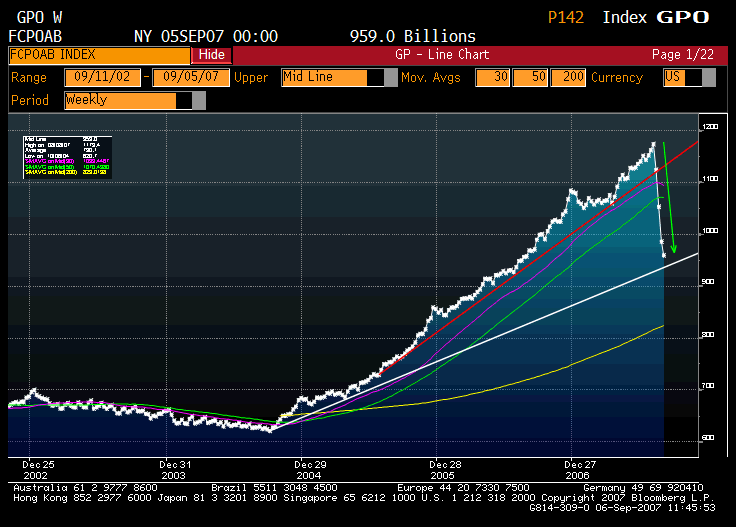Actually, the warning is old news. I just thought I'd read up on their current report to see if something else was up. Just glancing it over so far, I didn't find any new alarm. If you find a fresh alarm in there, let me know.
CRISIS IN ASSET BACKED COMMERCIAL PAPER
by Mike Shedlock / Mish
http://globaleconomicanalysis.blogspot.com/
The Chart of the week is a chart of asset backed commercial paper courtesy of Minyanville's Bennet Sedacca.
In the chart below, note the drastic drop in asset backed commercial paper. In a mere four weeks, nearly 20% of the entire market has evaporated. Yes, evaporated. This is otherwise known as debt deflation or credit destruction. It is why I continue to be cautious about credit risk and financial markets in general.

Of note, there is a lot of issuance starting to surface in the longer term fixed rate corporate bond arena. I expect this to continue and feel that spreads will continue to widen and put pressure on profit margins.
CREDIT PROBLEMS VS. MARKET CONFIDENCE
As for the idea "credit problems are a matter of market confidence" ... a better way of stating it is: "credit problems arise from previous market overconfidence".
Certainly a major source of the problems we have seen recently started with unwarranted overconfidence and belief in models suggesting that home prices always go up. See [
http://globaleconomicanalysis.blogspot.com/2007/07/fitch-discloses-its-fatally-flawed.html] Fitch Discloses Its Fatally Flawed Rating Model for a discussion of one such massively flawed model.
Overconfidence in housing prices led to all sorts of foolish lending practices. Those debts can never be paid back.
Another source of overconfidence is called the Greenspan Put. There still today remains the misguided belief that the Fed can and will rescue the market from any problem. It can't for the simple reason THE FED CANNOT FORCE CONSUMERS TO BORROW OR BANKS TO LEND.
Look at the recent jobs numbers analysis in [
http://globaleconomicanalysis.blogspot.com/2007/09/moonbats-active-again-in-massive-jobs.html] Moonbats Active Again in Massive Jobs Disaster. What lenders want to take on additional massive risk in the face of that? Some may, but they will likely be punished for it.
What borrowers want to take on extra debt now? Once again some might but they too are likely to regret it. And those taking on debt out of desperation (no other source of funds) will eventually default, causing the lender to regret extending credit. Once the default rates gets high enough (and they will), the willingness to extend any credit will further shrink.
JOBS ARE KEY AND THE JOBS PICTURE IS BLEAK.
I keep mentioning this but it is a very important concept to understand: the Fed can only encourage lending and borrowing, it simply cannot force either lending or borrowing, nor can the Fed physically drop money out of helicopters. Besides, the Fed would not drop money out of helicopters even if they could, for the simple reason it would destroy their own wealth.
THE FED'S LIMITATIONS
Mr. Practical weighed in about the Fed's Limitations in reply to a reader question about the 12 Federal Reserve Banks— Minyan Mailbag— The Fed's Limitations:
Ultimately, the Fed is not a bottomless pit at the discretion of politicians eager to salve hurting constituents (by bailing them out of their own follies). The Fed does have a quasi-monopoly on money, which provides a nice steady income to its shareholders as monopolies usually do. The Fed and its shareholders know who butters their bread, and when push comes to shove, they won't feed their bread to the birds.
Bernanke cannot "drop dollars from helicoptors" because that would plummet the Fed's balance sheet [and ther dollar] into ruin. He is already stretching the rules to the breaking point (allowing the use of less than pristine collateral and a loan extension from one day to 30 days in order to ease lending to banks, allowing increased lending from the 'too large to fail' banks to 'less credit worthy' banks and to (their) non-banking entities such as mortgage division, brokerages, etc., etc.).
THERE IS A LIMIT AND THAT LIMIT IS FAST APPROACHING.
With that in mind, will someone please tell me how all this leveraged debt can be repaid, how the enormous carry trades that need to be unwound can be unwound without causing a catastrophe somewhere, why one or more major debt insurance companies will not blow sky high causing— initiating a cascade in (derivative) defaults, how $300-$500 trillion in derivatives and swaps floating around (all of it marked to model as opposed to marked to market) can hope to be paid or collected on when asset prices simply drop to zero as lenders hang on to their cash for dear life. (And, note that derivatives are a zero sum transaction— if one party gains, it must be at the expense of the counterparty; yet ALL of the derivatives issuers and purchasers are 'marking them to model' and carrying them on their books at a profit! NOT POSSIBLE!)
It can't be done. It only appeared possible because credit had been expanding fast enough to allow interest on previous debt to be paid from new debt. A GIANT PONZI SCHEME!
Once new credit contracts become difficult to obtain, and asset prices drop, it becomes impossible to service the old debt. The greatest financial experiment in history has really been nothing but one giant Ponzi scheme— the extension of credit based on models that work only as long as asset prices go up and liquidity is infinite.
Very few ever bother to figure out what the limitations of the Fed are. There is still limitless faith in the Fed, "misguided overconfidence" actually, that inflation is a one way street from the past, to the present, to the future. THE FED WILL NEVER ALLOW DEFLATION...But, can it stop it, short of destroying the financial system totally? IT COULDN'T IN 1930.
Remember the saying that housing prices have never gone down nationally [at least since the 1930s] and they never will? Even Greenspan believed that as late as May 2006, long after the housing bubble had burst. AG will indeed go down in economic history, but probably not as he supposed.
Has overconfidence prevented housing prices from totally collapsing or has overconfidence in flawed assumptions and almost free money led to a lending 'boom' that virtually guarantees a housing price bust at some point?
The fatal flaw in the housing boom was the obvious inability of marginal borrowers to service mortgage loans well beyond their means once home prices stopped rising and no longer provided them with the ability to refinance with the magic of 'price appreciation premiums.' While housing prices rose, housing related credit expansion continued as consumers treated their house as a virtual ATM. But the ATM bill has now come due. It is no longer dispensing cash; it is now sucking up dollars faster than most people can come up with.
The shattering of the one way housing price myth makes it one myth down and one to go. Next, the myth that inflation is a one way street from past, to present, to future— that deflation is impossible in a post 1930s world of fiat money— will be shattered as well.
Normxxx Here: Note that the problem with deflation is that it INCREASES the debt burden instead of inflating it away!
Credit booms have never ended in inflation in the past; and there is no reason to believe that this time is different. Credit booms end in deflation as credit simply vanishes.
LIKE ANY OTHER COMMODITY, AS CREDIT BECOMES SCARCER, ITS VALUE GOES UP!
The content of this message is NOT intended as professional advice. In fact, I am very unprofessional.
















